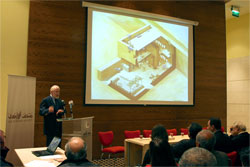Weekly Reports from Jordan
Choose Year: or Choose week
Discovering the Complex Challenges Facing Tall al-`Umayri
By Douglas Clark
Photos by Jillian Logee, et al.
The cultural heritage of Tall al-`Umayri, Jordan, part of the Madaba Plains Project, is in jeopardy. Land-ownership issues have forced major adjustments to research strategies and placed the site on a high-risk status. In that regard, it is not different from scores of archaeological sites in Jordan, which are owned privately.
The challenge comes when individual property rights and cultural heritage laws collide. `Umayri is one of the best preserved Bronze and Iron Age sites in the entire country (ca. 3,000-300 BC), but it is also owned by two private land owners. One is a historian with a PhD from the UK (Dr. Raouf Abujaber) and the other a land developer (Mr. Jebril Abu Aisha).
Three meetings deserve mention in this connection:
1) First, 28 January 2014 saw the gathering of around 100 people in the auditorium of the new Jordan Museum in Amman, participants coming from the royal family, from the government, from prestigious university positions, from friends of archaeology and heritage in Jordan. During that meeting I made a presentation on the wealth of `Umayri’s remains (archaeologists should be forgiven for always claiming that theirs is the “best” site in the cosmos … especially if it’s true!), followed by short presentations by a distinguished panel of stake holders, and audience participation (for reports on the January event, visit this link and the online version of the winter issue of La Sierra Digs (quarterly newsletter of the Center for Near Eastern Archaeology at La Sierra University). See especially the comments of HRH Princess Sumaya, which were printed in full in the newsletter.
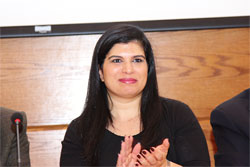
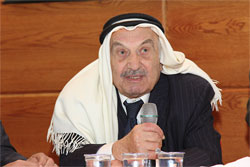 In many ways, this meeting, co-organized by Sharifa Nofa Nasser (then Director of the Jordan Museum and President of the Friends of the Archaeology and Heritage of Jordan) and me, was seminal not only in raising the discussion about `Umayri to this level of awareness and serious conversation among the major stakeholders, Jordanian and foreign, but in using `Umayri as a type site for scores of other archaeological projects located on private land. Thus the fate of many extremely promising sites is in some ways wrapped up in these complex discussions. It was also important because of the consistently well-informed and passionate speeches which all recommended a course of action which would both protect the rights of land owners and protect the national, indeed global, cultural heritage represented at `Umayri – the land must come into the possession of the Department of Antiquities and the owners must be fairly compensated. The way forward will likely include some kind of land-swap, government support, and perhaps land-owner donations. As gestures of good faith, both land owners offered 500,000 Jordanian dinars’ worth of their land as part of the deal, for a total of one million dinars (=$1.4 million).
In many ways, this meeting, co-organized by Sharifa Nofa Nasser (then Director of the Jordan Museum and President of the Friends of the Archaeology and Heritage of Jordan) and me, was seminal not only in raising the discussion about `Umayri to this level of awareness and serious conversation among the major stakeholders, Jordanian and foreign, but in using `Umayri as a type site for scores of other archaeological projects located on private land. Thus the fate of many extremely promising sites is in some ways wrapped up in these complex discussions. It was also important because of the consistently well-informed and passionate speeches which all recommended a course of action which would both protect the rights of land owners and protect the national, indeed global, cultural heritage represented at `Umayri – the land must come into the possession of the Department of Antiquities and the owners must be fairly compensated. The way forward will likely include some kind of land-swap, government support, and perhaps land-owner donations. As gestures of good faith, both land owners offered 500,000 Jordanian dinars’ worth of their land as part of the deal, for a total of one million dinars (=$1.4 million).
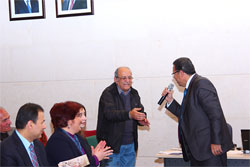 2) The second meeting, held on Monday, 14 July, also occurred at the Jordan Museum. Since administrators of several of the MPP-`Umayri consortium institutions were in Jordan for a short tour of the country’s archaeological landscape and a visit to our site, it made sense to connect them with the issues and with some of the participants. We had originally planned for an hour-long discussion with Department of Antiquities officials and others, but the discussion went on for a couple of hours. Participants included Dr. Monther Jamhawi (Director General of the DoA), Dr. Ghazi Bisheh (former Director General of the DoA), Sharifa Nofa Nasser (President of the Friends of Archaeology and Heritage of Jordan), Dr. Zeidan Kafafi (former Director of the Jordan Museum and professor of archaeology at Yarmouk University), Dr. Maysoon Nahar (Dean of Archaeology at Jordan University), Yazid Elyan (Director of the Amman Region of the DoA), Dr. Barbara Porter (Director of the American Center of Oriental Research in Amman), Jihad Haroun (Director of Scientific Research at the DoA and currently a graduate student in archaeology and biblical studies at La Sierra), Morag Kersel (Prehistorian and archaeology ethicist), and Abdelrahim Al-Dwikat (DoA), along with MPP-`Umayri consortium school administrators: President Randal and Deanna Wisbey and Provost Steve and Carol Pawluk of La Sierra University; Vice President Nancy Lecourt of Pacific Union College; and President Mark and Kris Haynal of Canadian University College.
2) The second meeting, held on Monday, 14 July, also occurred at the Jordan Museum. Since administrators of several of the MPP-`Umayri consortium institutions were in Jordan for a short tour of the country’s archaeological landscape and a visit to our site, it made sense to connect them with the issues and with some of the participants. We had originally planned for an hour-long discussion with Department of Antiquities officials and others, but the discussion went on for a couple of hours. Participants included Dr. Monther Jamhawi (Director General of the DoA), Dr. Ghazi Bisheh (former Director General of the DoA), Sharifa Nofa Nasser (President of the Friends of Archaeology and Heritage of Jordan), Dr. Zeidan Kafafi (former Director of the Jordan Museum and professor of archaeology at Yarmouk University), Dr. Maysoon Nahar (Dean of Archaeology at Jordan University), Yazid Elyan (Director of the Amman Region of the DoA), Dr. Barbara Porter (Director of the American Center of Oriental Research in Amman), Jihad Haroun (Director of Scientific Research at the DoA and currently a graduate student in archaeology and biblical studies at La Sierra), Morag Kersel (Prehistorian and archaeology ethicist), and Abdelrahim Al-Dwikat (DoA), along with MPP-`Umayri consortium school administrators: President Randal and Deanna Wisbey and Provost Steve and Carol Pawluk of La Sierra University; Vice President Nancy Lecourt of Pacific Union College; and President Mark and Kris Haynal of Canadian University College.
Several ideas were explored, some of which generated warm debates among Jordanian officials, indicating just how complex some of these issues are and how much passion they stir up. Raising public awareness about cultural heritage through the media came up. As did hiking the fees for archaeologists who excavate in Jordan. Probably most promising, even if by no means a sure thing, was a suggested fee attached to all land transfers in the Kingdom each year which would funnel funds into a foundation for just such needs as `Umayri presents. I pushed something that has been developing in my mind for some time, an expanded notion of an idea already forwarded by the mayor of the Greater Amman Municipality, that of making `Umayri the southern archaeological “gateway” into Amman, since it rests adjacent to the Airport Highway which brings most of the traffic from the south into the city. Because `Umayri is a Bronze and Iron Age site (ca. 3,000 to 300 BC), and `Umayri East (across the highway) is classical (Greek, Roman, and Byzantine – ca. 300 BC - AD 700), and `Umayri North an Islamic site (7th century up until the beginning of the 20th century), and the modern village of Bunayat (from where our workers come) is recent, all of the `Umayris together nicely encompass the past 5,000 years. This enlarged “gateway” concept might have possibilities.
No decisions were made at this meeting, but participants did commit to continuing the quest to resolve this issue for the benefit of land owners and the people of Jordan.
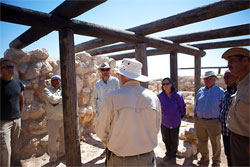 3) The third meeting took place on Wednesday at the tell. Immediately following our second breakfast (hard-working archaeologists need nourishment, after all, so why not four meals a day?), we welcomed several visitors for a follow-up conversation and some brain-storming for new options in the shadow of the burned beams of the partially restored four-room house. Those present included our two DoA representatives, Abdelrahim Al-Dwikat and Jihad Haroun, Yazid Elyan (Director of the Amman District of the DoA), Bassem Mohamid (Director of the Madaba District of the DoA), Barbara Porter from ACOR, Gary Rollefson, Morag Kersel, and Yorke Rowan (prehistorians who work in Jordan). Kent Bramlett and I showed them some of `Umayri’s architectural treasures and then we stood around, trying to come with fresh approaches.
3) The third meeting took place on Wednesday at the tell. Immediately following our second breakfast (hard-working archaeologists need nourishment, after all, so why not four meals a day?), we welcomed several visitors for a follow-up conversation and some brain-storming for new options in the shadow of the burned beams of the partially restored four-room house. Those present included our two DoA representatives, Abdelrahim Al-Dwikat and Jihad Haroun, Yazid Elyan (Director of the Amman District of the DoA), Bassem Mohamid (Director of the Madaba District of the DoA), Barbara Porter from ACOR, Gary Rollefson, Morag Kersel, and Yorke Rowan (prehistorians who work in Jordan). Kent Bramlett and I showed them some of `Umayri’s architectural treasures and then we stood around, trying to come with fresh approaches.
The complexity of our plight has become more clear with the passing of time and the enlarged circles of conversation partners. Most feel that our next steps have to include visits with members of the Cabinet who are in positions to make a difference. So, as a result of these three meetings, especially the last two, we are working on several important appointments this week and next. Here’s hoping we find a way of simplifying the complex and solving the problem!
![Panel Participants (from left) Douglas Clark, Dr. Monther Jamhawi (Director General of the Department of Antiquities [DoA]), Dr. Raouf Abujaber (land owner and 19th-century historian), Dr. Ghazi Bisheh (former Director General of the DoA), HRH Princess Sumaya (patron with her father, HRH Prince Hassan, of Jordanian archaeology and long-time friend of the `Umayri excavations), Aqel Biltaji (Mayor of the Greater Amman Municipality and former Minister of Tourism), Dr. Gary Rollefson (prehistorian and long-time researcher in Jordan), Dr. Morag Kersel (prehistorian and specialist in the ethics of archaeology), and Dr. Barbara Porter (Director of the American Center of Oriental Research in Amman).](/umayri/editor/images/weeklyreports/2014/misc/Panel-Discussion-at-January-Meeting-small.jpg)
